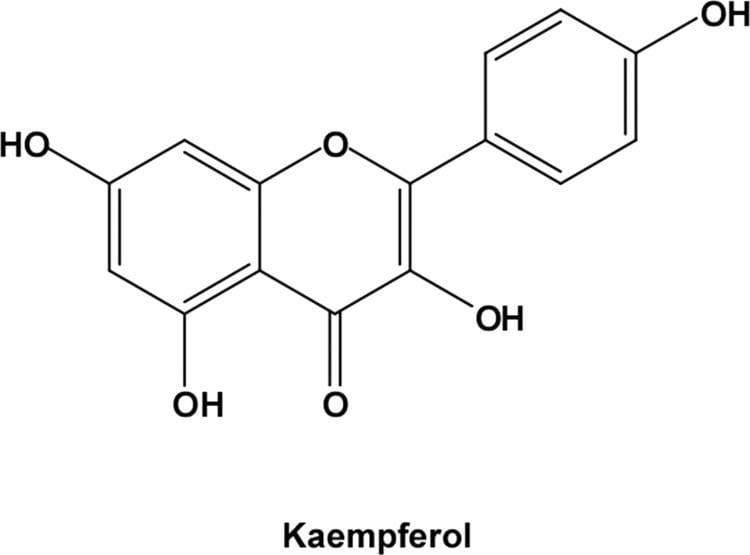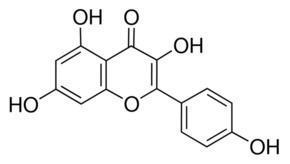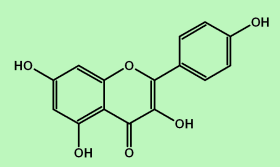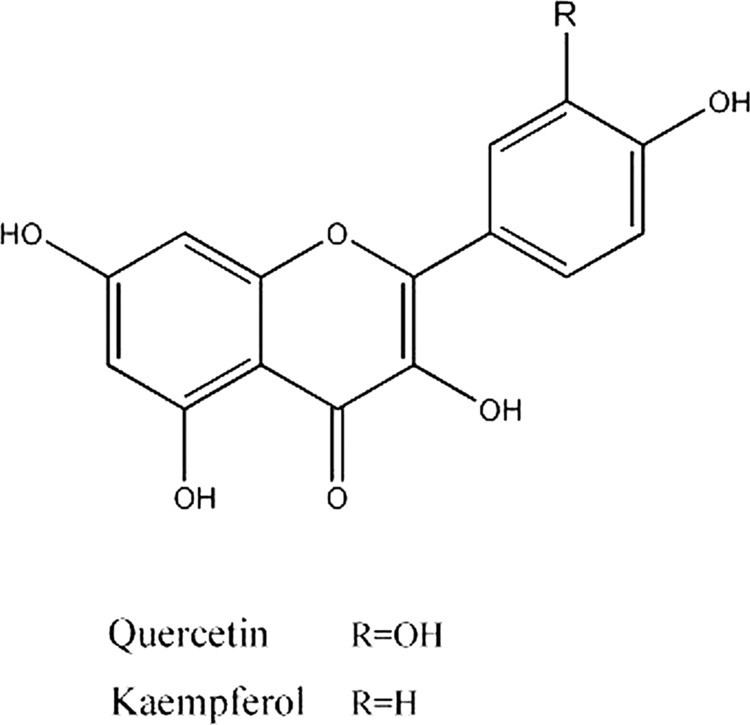Formula C15H10O6 | Molar mass 286.23 g/mol | |
 | ||
Kaempferol is a natural flavonol, a type of flavonoid, found in a variety of plants and plant-derived foods. Kaempferol is a yellow crystalline solid with a melting point of 276–278 °C (529–532 °F). It is slightly soluble in water and highly soluble in hot ethanol, ethers, and DMSO. Kaempferol acts as an antioxidant by reducing oxidative stress. Many studies suggest that consuming kaempferol may reduce the risk of various cancers, and it is currently under consideration as a possible cancer treatment.
Contents
- How to pronounce kaempferol
- Natural occurrence
- In plants and food
- Biosynthesis
- Pharmacokinetics
- Potential pharmacology
- Anti cancer effects
- Breast cancer
- Ovarian cancer
- Leukemia
- Bladder prostate and colorectal cancer
- Gastric cancer
- Pancreatic cancer
- Lung cancer
- Diabetes
- Cardiovascular disorders
- Anti bacterial activity
- Anti viral activity
- Antioxidant effects
- References

How to pronounce kaempferol
Natural occurrence
Kaempferol is a secondary metabolite found in many plants, plant-derived foods, and traditional medicines.
In plants and food

Kaempferol is common in Pteridophyta, Pinophyta and Angiospermae. Within Pteridophyta and Pinophyta, kaempferol has been found in diverse families. Kaempferol has also been identified in both Dicotyledons and Monocotyledons of Angiosperms. The total average intake of flavonols and flavones in a normal diet is estimated as 23 mg/day, to which kaempferol contributes approximately 17%. Common foods that contain kaempferol include: apples, grapes, tomatoes, green tea, potatoes, onions, broccoli, Brussels sprouts, squash, cucumbers, lettuce, green beans, peaches, blackberries, raspberries, and spinach. Plants that are known to contain kaempferol include Aloe vera, Coccinia grandis, Cuscuta chinensis, Euphorbia pekinensis, Glycine max, Hypericum perforatum, Moringa oleifera, Rosmarinus officinalis, Sambucus nigra, and Toona sinensis.
Biosynthesis
The biosynthesis of kaempferol occurs in four major steps:


The amino acid phenylalanine is formed from the Shikimate pathway, which is the pathway that plants use in order to make aromatic amino acids. This pathway is located in the plant plastid, and is the entry to the biosynthesis of phenylpropanoids.

The phenylpropanoid pathway is the pathway that converts phenylalanine into tetrahydroxychalcone. Flavonols, including kaempferol, are products of this pathway.
Pharmacokinetics

Kaempferol is ingested as a glycoside, absorbed in the small intestine, usually by passive diffusion due to kaempferol’s lipophilicity, and metabolized in various areas of the body. In the small intestine, kaempferol is metabolized to glucuronides and sulfoconjugates by intestinal enzymes. It can also be metabolized by colon microflora which can hydrolyze the glycosides to aglycones or form simple phenolic compounds. These compounds can be absorbed or excreted. Kaempferol is also extensively metabolized in the liver to form glucurono-conjugated and sulfo-conjugated forms. These forms of kaempferol, and kaempferol itself, can then be excreted in urine. About 2.5% of kaempferol ingested is excreted as urine. Much of the rest of ingested kaempferol is present in the plasma and tissues in nanomolar concentrations.
Potential pharmacology

Numerous preclinical studies have shown kaempferol and some glycosides of kaempferol have a wide range of pharmacological activities, including antioxidant, anti-inflammatory, antimicrobial, anticancer, cardioprotective, neuroprotective, antidiabetic, antiosteoporotic, estrogenic/antiestrogenic, anxiolytic, analgesic, and antiallergic activities.
Anti-cancer effects
In vitro studies along with some animal testing has demonstrated the wide range of potential anti-cancer properties of kaempferol. It has been shown in malignant cancer cells to interrupt cell growth, limit angiogenesis, induce apoptosis, and to reduce their available energy and ability to metastasize. Kaempferol has also been shown to reduce MMP-3 protein activity inferring potential ability to reduce metastasis.
Breast cancer
Estrogen receptors are important in both maintaining a normal mammary gland, and in the development of primary and secondary breast cancer. Kaempferol has been shown to interact with the estrogen receptor pathway and alter signaling in order to help slow growth. This compound exhibits ability to lower levels of Aromatase. Kaempferol has also been found to induce apoptosis in breast cancer cells through extracellular signal-regulated kinase ½ activation and up-regulation of p53.
Ovarian cancer
Available evidence has shown that kaempferol can “inhibit VEGF production and suppress ovarian cancer cell metastasis in vitro”.
Leukemia
Kaempferol has been shown to reduce growth in pro-myelocytic leukemia cells through altering the cell cycle.
Bladder, prostate and colorectal cancer
Various studies have shown that intake of kaempferol containing foods is not significantly associated with decreased bladder cancer, prostate cancer, or colorectal cancer risk.
Gastric cancer
A case controlled study found that “consumption of kaempferol-containing foods was associated with a reduced gastric cancer risk”.
Pancreatic cancer
An eight-year study found the consumption of three flavonols (kaempferol, quercetin, and myricetin) correlated with a lower risk of pancreatic cancer among current smokers, but not non-smokers or ex-smokers.
Lung cancer
In A549 lung cancer cells, kaempferol up-regulated pro-apoptotic bax and bad genes, while it down-regulated anti-apoptotic bcl-2 and bcl-xL expression. This resulted in an increase in apoptosis of the cancer cells.
Diabetes
A correlation was found between increased levels of kaempferol in the diet and a reduced relative risk of type 2 diabetes in a cohort study in 2005. Additionally, 6-methoxykaempferol-3-O-β-D-robinobioside was shown to have significant inhibitory activity of aldose reductase, which plays an important role in diabetic complications.
Cardiovascular disorders
A cohort study in men showed that consumption of flavonoid containing food decreased the risk of mortality from coronary heart disease. Another cohort study showed that high intake of tea is inversely associated with myocardial infarction. Kaempferol has also been shown to have a protective effect on the apoptosis induced by the ischemia/reperfusion of cardiac cells. Due to this, it has a promising pharmacological role in preventing cardiovascular disease.
Anti-bacterial activity
In a four-week study, kaempferol and its glycosides decreased the number of Helicobacter pylori colonies in gerbils. It also has been shown to work synergistically with antibiotics.
Anti-viral activity
Kaempferol has been shown to inhibit or decrease the activity of enzymes that partake in viral infection such as reverse transcriptase, viral proteases and neuraminidase.
Antioxidant effects
Kaempferol has been shown to have an array of antioxidant effects in vitro and in vivo. At low concentrations, its acts as a super-oxide scavenger, specifically against the highly reactive hydroxyl radical and peroxynitrite species. At high concentrations it increases the activity or expression of antioxidant enzymes such as superoxide dismutase, catalase, and heme oxygenase-1. Kaempferol can prevent the oxidation of low-density lipid proteins indicating a potential protective role in atherosclerosis.
